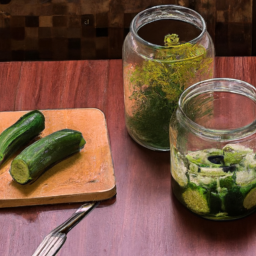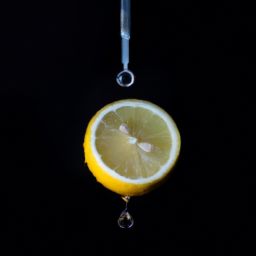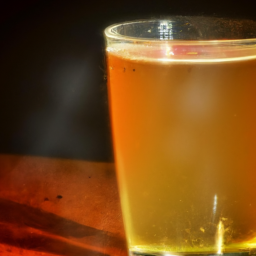I’ve always adored pickles and the zesty, savory flavor they add to dishes. However, what captivates me even more than the pickles is the brine they’re soaked in.
There’s just something about that brine that is so addicting. And that’s why I decided to learn how to make my own Mt Olive pickle juice.
Making pickle juice may seem like a daunting task, but it’s actually quite simple and requires only a few ingredients and some basic kitchen equipment.
In this article, I’ll walk you through the steps to create your own delicious Mt Olive pickle juice. So, grab a jar of pickles and let’s get started!
Key Takeaways
- Proper sterilization of storage containers is crucial for making safe and long-lasting pickle juice.
- The ratio of pickles to vinegar solution affects the intensity of the pickle flavor, so it’s important to find the right balance.
- There are various uses for filtered pickle juice, and it can also provide health benefits.
- Experimenting with different vegetables and seasonings can lead to a unique and personalized taste.
Gather Your Ingredients
Now, you’re gonna need to grab all your ingredients if you want to start making that delicious Mt Olive pickle juice.
First off, you’ll need to get your hands on some cucumbers. You can use different varieties of cucumbers such as Kirby, Persian, or English cucumbers. It’s important to choose firm and unblemished cucumbers for the best results.
Aside from cucumbers, you can also add other vegetables to your pickle juice such as garlic, dill, and onions. These ingredients will add more flavor to your pickle juice and give it a unique taste. Don’t be afraid to experiment with different vegetables to find the perfect combination for your taste buds.
Now that you have your ingredients, it’s time to move on to the next step, which is sterilizing your storage container.
Sterilize Your Storage Container
Proper sterilization is crucial in maintaining the quality and safety of your homemade pickle juice. Before pouring the hot liquid into your container of choice, make sure to thoroughly wash it with soap and water.
Rinse it thoroughly and then immerse it in boiling water for at least 10 minutes. Dry the container completely before pouring the hot juice.
When it comes to storage containers, there are various options available. Glass jars, plastic containers, and stainless steel bottles are all suitable choices. However, it’s important to choose a container that is non-reactive and doesn’t contain any harmful chemicals that may leach into your pickle juice.
Mason jars with airtight lids are a popular choice for pickling enthusiasts. Once you’ve properly sterilized your container, it’s time to prepare your pickles.
Prepare Your Pickles
Now that my storage container’s sterilized, it’s time to prepare the pickles. First, I’ll need to decide whether to slice or dice them according to my preference.
Then, I can add seasonings such as garlic, dill, or mustard seeds to enhance the flavor.
Slicing or Dicing Pickles
If you want to add some texture to your pickle juice, try slicing or dicing the pickles before adding them to the jar.
Slicing techniques can vary depending on the desired presentation of the pickles in the final product. Some people prefer thin and uniform slices, while others like thicker and more irregular pieces. Dicing the pickles can also add a unique touch to the texture of the pickle juice, creating a chunkier consistency.
When slicing or dicing the pickles, it’s important to use a sharp knife to ensure clean cuts and to prevent squishing or mashing the pickles. Additionally, consider the size and shape of the jar when slicing or dicing the pickles. If using a narrow jar, thin slices may be more practical to fit more pickles in the jar. However, if using a wider jar, thicker slices or even diced pickles can create a more visually appealing presentation.
Once the pickles have been sliced or diced to your liking, it’s time to move on to adding seasonings to the pickle juice.
Adding Seasonings
Enhance the flavor of your homemade pickles by adding a blend of herbs and spices to the brine. The seasoning combinations are endless, but popular choices include garlic, dill, mustard seeds, and red pepper flakes. Experiment with different combinations to find your own signature blend.
Be sure to taste test your brine before adding the pickles to ensure the flavors are balanced. When adding seasonings, it’s important to keep in mind that a little goes a long way. Start with small amounts and gradually add more until you achieve the desired taste. Don’t forget to consider the heat level of your seasonings – some spices can pack a punch!
Once you’ve added your seasonings, allow the brine to sit for a few hours to allow the flavors to meld together.
To transition into the next section, it’s important to note that heating your vinegar solution is necessary to properly dissolve the salt and sugar and allow the seasonings to infuse into the brine.
Heat Your Vinegar Solution
Once you’ve added your salt and water, it’s time to heat up the vinegar solution. This step is crucial because it’ll help dissolve the salt and infuse the flavors of the seasonings you added earlier.
You can either heat up the vinegar solution in a saucepan over medium heat or in the microwave for a few minutes until it reaches a boiling point. Alternative methods, such as using a slow cooker or a sous vide machine, can also be used to heat up the vinegar solution. However, using these methods might take a longer time, but it provides the benefit of infusing the flavors slowly and evenly throughout the solution.
Once the vinegar solution has reached a boiling point, remove it from the heat source and let it cool down to room temperature.
Now that your vinegar solution is ready, it’s time to combine your pickles and vinegar solution. This process will allow the flavors of the seasonings to blend with the pickles and create that delicious tangy taste that we all love.
Combine Your Pickles and Vinegar Solution
After heating up and cooling down the vinegar solution, it’s time to mix it with the pickles to create the perfect tangy flavor. The flavor profile of your pickle juice will depend largely on the ratio of pickles to vinegar solution that you use.
For a more intense pickle flavor, use a higher ratio of pickles to vinegar. If you prefer a milder flavor, use a higher ratio of vinegar to pickles. It’s all about finding the ideal balance for your taste preferences.
To combine the pickles and vinegar solution, simply add the pickles to the cooled vinegar mixture and stir well. Be sure to use a container that is large enough to hold all the pickles and vinegar solution with room to spare.
Allow the mixture to cool in the refrigerator for at least 24 hours before using to ensure the flavors have fully melded together.
Allow the Mixture to Cool
As the steam rises from the freshly combined mixture, it’s time to let it cool down in the refrigerator. Cooling the mixture is a crucial step in the process of making Mt. Olive pickle juice.
Here are a few ideas for discussing the cooling process:
-
Potential issues: One of the most common issues that may arise during the cooling process is the formation of a cloudy residue. This can be prevented by covering the mixture with a lid or plastic wrap. Additionally, the pickle juice may become too salty if it’s not cooled properly. Therefore, it’s recommended to follow the recommended cooling methods to ensure that the pickle juice is not only clear but also tasty.
-
Recommended cooling methods: The best way to cool down the mixture is to put it in the refrigerator. Once it’s in the refrigerator, it’s recommended to let it cool down for at least 24 hours before using it. This will allow the flavors to meld together, resulting in a more flavorful pickle juice. Another recommended method is to put the mixture in an ice bath. This will speed up the cooling process, but it may also dilute the mixture slightly.
Now that the mixture’s been cooled, it’s time to strain the pickle juice and enjoy the delicious taste of Mt. Olive pickle juice.
Strain the Pickle Juice
Now that the mixture has cooled, I’m ready to filter out any remaining sediment and extract the tangy essence of the pickles from the brine. To do this, I’ll need a fine mesh strainer or cheesecloth.
I prefer the cheesecloth method as it helps to remove even the tiniest bits of sediment and leaves me with a clearer juice. To strain the pickle juice, I’ll place the cheesecloth over a clean jar and pour the mixture through it.
Once all the juice has been strained, I’ll discard the solids left in the cheesecloth. The filtered pickle juice can now be used in many ways. Some people like to drink it straight for its health benefits, such as replenishing electrolytes and aiding digestion.
Others use it to flavor cocktails, marinades, dressings, and even as a substitute for vinegar in recipes. With the pickle juice strained and ready to use, it’s time to move on to the next step: storing your pickle juice.
Keeping it fresh and flavorful is essential if you want to enjoy it for longer than a few days.
Store Your Pickle Juice
I always make sure to store my pickle juice properly to keep it fresh and flavorful for as long as possible.
The key to proper storage is choosing the right container and using the right techniques.
When it comes to containers, I prefer glass jars or plastic containers with tight-fitting lids to keep air out and prevent contamination.
As for storage techniques, I recommend keeping the pickle juice in the fridge and using it within a few weeks for optimal taste and quality.
Choosing the Best Storage Container
To ensure your homemade pickle juice stays fresh, you’ll want to find the perfect container. Here are some material and size recommendations, as well as proper cleaning techniques to help you choose the best storage container for your pickle juice:
-
Material Recommendations: The best materials for storing pickle juice are glass or food-grade plastic. Avoid using metal containers as they can react with the acidity of the vinegar in the pickle juice, altering the taste and quality of the juice.
-
Size Recommendations: Choose a container that is appropriate for the amount of pickle juice you plan to store. A smaller container will prevent the juice from being exposed to too much air, which can cause it to spoil faster. Additionally, a larger container may be more difficult to store in the refrigerator.
-
Proper Cleaning Techniques: Before storing your pickle juice, make sure to clean your container thoroughly with warm soapy water and rinse it well. Avoid using any harsh chemicals or abrasive sponges that can damage the container’s surface.
By following these material and size recommendations and proper cleaning techniques, you can ensure that your homemade pickle juice stays fresh for a longer period of time. In the next section, I’ll discuss some proper storage techniques for your delicious pickle juice.
Proper Storage Techniques
Ensuring that your homemade pickle juice stays fresh and delicious for as long as possible is crucial. Proper storage techniques will prevent spoilage and keep the flavors intact.
The temperature and duration of storage are key factors to consider when storing your pickle juice. Ideally, the pickle juice should be stored in an airtight container in the refrigerator. The temperature of the refrigerator should be around 40°F. This temperature will slow down the growth of bacteria and keep your pickle juice fresh for a longer period.
It’s important to note that once you’ve opened the jar of pickle juice, it should be consumed within a reasonable time frame. The recommended duration for the storage of opened pickle juice is around 1 to 2 months.
Additionally, leftover pickle juice can be used in a variety of recipes, such as marinades, dressings, or even as a brine for other vegetables. With proper storage techniques, you can enjoy the flavor of homemade pickle juice for a longer period and experiment with a variety of recipes.
Enjoy Your Homemade Pickle Juice
I absolutely love pickle juice! Not only is it a tasty and refreshing beverage, but it also has many uses in cooking and baking.
In this subtopic, we’ll explore the best ways to enjoy your homemade pickle juice. Whether you’re drinking it straight up or incorporating it into your favorite recipes, there are plenty of options.
So go ahead, enjoy your homemade pickle juice. Sip it on its own or use it as a secret ingredient in your next meal. The possibilities are endless!
Drinking Pickle Juice
You can satisfy your craving for a tangy and salty drink by gulping down some pickle juice. It’s also a delicious and refreshing way to quench your thirst. If you’re feeling adventurous, you can even take pickle juice shots as a way to boost your immune system and improve digestion.
But drinking pickle juice isn’t just about satisfying your taste buds. It’s also an excellent way to replenish your electrolytes after a strenuous workout. So next time you hit the gym or go for a run, consider reaching for a bottle of pickle juice instead of sports drinks or sugary sodas. Plus, it’s a more affordable and natural alternative that will leave you feeling energized and hydrated.
And if you’re feeling creative, you can also use pickle juice in recipes to add a zesty flavor to your dishes.
Using Pickle Juice in Recipes
Adding a splash of briny liquid to your marinades or dressings can give your dishes an extra kick of flavor and acidity. One ingredient that can do just that is pickle juice. Not only does it add a tangy taste to your dishes, but it also has some surprising benefits.
Here are a few reasons why you should consider using pickle juice in your recipes:
- It adds a unique flavor to cocktails that pairs well with vodka or gin.
- The electrolytes in pickle juice can help athletes replenish their bodies after a workout.
- It can be used as a substitute for vinegar or lemon juice in salad dressings or marinades.
- Pickle juice can also be used to marinate meats, giving them a tender and juicy texture.
By experimenting with different ways to incorporate pickle juice into your meals, you can add a distinctive taste that will make your dishes stand out.
Speaking of experimentation, let’s move on to the next section and explore some flavor variations you can try.
Experiment with Flavor Variations
I love experimenting with different flavors when making my own pickle juice. One way to add some extra kick is by incorporating various spices and herbs, such as dill, garlic, or even red pepper flakes.
Additionally, trying out different pickle varieties, like sweet or spicy, can completely change the taste of your homemade pickle juice.
Adding Spices and Herbs
Mix in some garlic and dill for a tangy and flavorful pickle juice. Herbs and spices can make all the difference in the taste of your pickle juice. When it comes to adding flavor to your pickle juice, it’s important to understand the difference between herbs and spices. Herbs come from the leaves of plants, while spices come from the seeds, berries, bark, or roots of plants.
Here’s a table of some common herbs and spices you can add to your pickle juice:
| Herbs | Spices |
|---|---|
| Dill | Mustard Seed |
| Garlic | Black Peppercorns |
| Bay Leaves | Coriander Seeds |
| Thyme | Cinnamon Sticks |
| Rosemary | Cloves |
By adding these herbs and spices to your pickle juice, you can create unique flavor combinations that will make your pickles stand out. Once you’ve experimented with different herbs and spices, you can move on to trying different pickle varieties.
Trying Different Pickle Varieties
Now that we’ve talked about adding spices and herbs to our homemade pickle juice, let’s dive into the fun part – trying different pickle varieties! As someone who loves pickles, I’ve always been curious about how different types of pickles would affect the taste of the juice. So, I decided to conduct a pickle taste test to find out.
Here are some of the varieties I tried and how they affected the flavor of the juice:
-
Dill Pickles – These classic pickles added a tangy and slightly sour taste to the juice.
-
Bread and Butter Pickles – These sweeter pickles gave the juice a hint of sweetness and a more complex flavor.
-
Spicy Pickles – These pickles added a nice kick of heat to the juice, perfect for those who love spicy cocktails.
-
Garlic Pickles – These pickles gave the juice a strong garlic flavor, perfect for savory cocktails.
Using different pickle varieties can really elevate the flavor of your homemade pickle juice. Not only can you use the juice for pickling vegetables, but you can also use it to create unique pickle juice cocktails. Experiment with different pickle varieties to see which ones you like best!
Frequently Asked Questions
How long can the homemade pickle juice be stored for?
Homemade pickle juice can be stored for up to 2 months in the fridge. It can be used for marinating meat, adding flavor to salad dressings, and as a hangover cure. Drinking pickle juice also has health benefits, such as reducing muscle cramps and aiding digestion.
Can different types of vinegar be used for the solution?
Yes, there are alternatives to vinegar that can be used for pickle juice, such as apple cider vinegar or rice vinegar. These can also create flavor variations depending on personal preference.
Can the recipe be adjusted for a smaller or larger batch of pickle juice?
When adjusting the recipe, I recommend using a ratio of 1:1 for vinegar and water. Start with a smaller quantity and adjust to taste. Remember to use the same ratio for spices and salt. Experiment with different quantities to achieve the desired flavor and acidity in your pickle juice.
Can the same pickles be used multiple times to make more juice?
Yes, I’ve found that using pickles multiple times to make more juice is possible. However, the flavor may vary with each use. It’s best to start with fresh pickles for optimal flavor.
Is it necessary to use a specific type of storage container for the pickle juice?
Using alternative storage options for homemade pickle juice can have numerous benefits. According to a study, using glass containers can reduce the risk of harmful chemicals leaching into the juice. So, it’s worth investing in proper storage to enjoy the full benefits.
Conclusion
Well folks, it’s official. I’m now the master of pickle juice making. If you’re anything like me, you can’t get enough of that tangy, salty goodness. And now, with this recipe, you too can have a never-ending supply of Mt. Olive pickle juice.
Seriously, I never thought I’d be able to make my own pickle juice, but it turns out it’s not that hard. And let me tell you, the taste is unbeatable. Forget about buying expensive pickle juice at the store, now you can have it fresh and homemade.
So go ahead, give it a try and impress all your friends with your newfound pickle juice skills. Trust me, they’ll be begging you for the recipe.
Ilana has been a vegan for over 10 years. She originally made the switch for health reasons, but soon found herself becoming more and more passionate about the ethical and environmental implications of a vegan lifestyle. Ilana is the author of The Graceful Kitchen, a blog all about veganism. She loves to cook up delicious and nutritious vegan meals, and share her recipes with others who are interested in leading a cruelty-free life. Ilana is also a strong advocate for using whole foods as the foundation of a healthy diet, and believes that going vegan is one of the best ways to achieve this.










